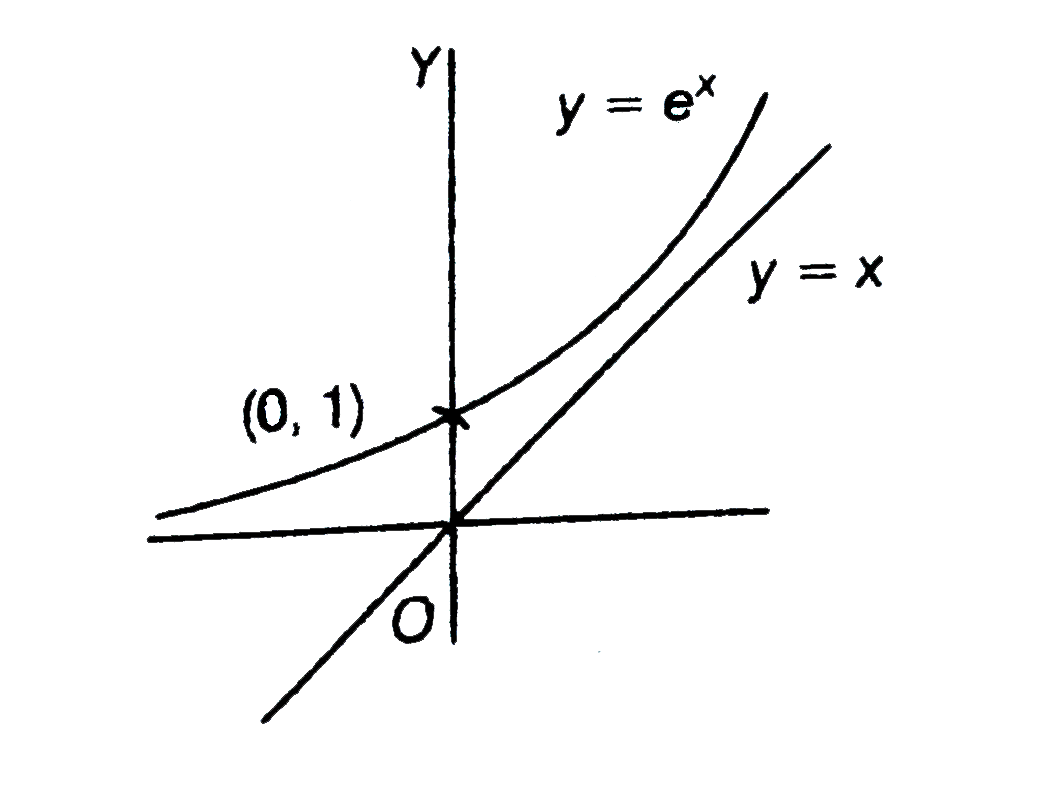If the sets A and B are defined are defined as A={(x,y):y=ex,x∈R},B={(x,y):y=x,x∈R}then
a. B⊂A
b. A⊂B
c. A∩B=ϕ
d. A∪BSolution in Punjabi
B⊂A
A⊂B
A∩B=ϕ
A∪B
The correct Answer is:B
A={(x,y):y=ex,x∈R}
B={(x,y):y=x,x∈R}

∴A⊂B
Topper's Solved these Questions
- BOOK - ARIHANT MATHSCHAPTER - SETS, RELATIONS AND FUNCTIONS EXERCISE - Exercise (More Than One Correct Option Type Questions)3videos
SETS, RELATIONS AND FUNCTIONS
- BOOK - ARIHANT MATHSCHAPTER - SETS, RELATIONS AND FUNCTIONS EXERCISE - Exercise (Passage Based Questions)6videos
SETS, RELATIONS AND FUNCTIONS
- BOOK - ARIHANT MATHSCHAPTER - SETS, RELATIONS AND FUNCTIONS EXERCISE - Exercise For Session 310videos
SETS, RELATIONS AND FUNCTIONS
- BOOK - ARIHANT MATHSCHAPTER - SEQUENCES AND SERIESEXERCISE - Exercise (Questions Asked In Previous 13 Years Exam)38videos
SEQUENCES AND SERIES
- BOOK - ARIHANT MATHSCHAPTER - THE STRAIGHT LINESEXERCISE - The Straight Lines Exercise 8 : (Questions Asked in Previous 13 years Exams)1videos
THE STRAIGHT LINES
Similar Questions
Let L be the set of all straight lines in the Euclidean plane. Two lines l1 and l2 are said to be related by the relation R if l1 is parallel to l2. Then, relation R is not
01:40View SolutionLet f and g be real valued functions defined as
f(x)=⎧⎪⎨⎪⎩7x2+x−8,x≤14x+5,1<x≤78x+3,x>7 g(x)=⎧⎪⎨⎪⎩|x|,x<−30,−3≤x<2x2+4,x≥2
The value of gof(0)+fog(−3) is
a. −8
b. 0
c. 8
d. 1602:45View SolutionThe values of bandc for which the identity of f(x+1)−f(x)=8x+3 is satisfied, where f(x)=bx2+cx+d,are
02:15View SolutionLet a,b,c be in A.P. and |a|<1,|b|<1|c|<1.ifx=1+a+a2+....to ∞,y=1+b+b2+....to ∞and,z=1+c+c2+...to ∞, then x,y,z are in
02:06View SolutionSolve the following system of inequalities graphically
x+5y≤25,2x+2y≥2,2x−2y≤0,x≥0,y≥003:33View SolutionIf A={(x, y):y=ex, x∈R}and B={(x,y):y=x,x∈R} , then write A∩B.
02:47View SolutionA relation R is defined from A to B by R={(x, y)}, "where" x in NN, y in NN, and x+y=4}. Then, R is (A) symmetric (B) reflexive (C) equivalence (D) both (A) and (B)
01:15View SolutionIf set A and B are defined as
A={(x,y)∣y=1x,0≠x∈R},B={(x,y)∣y=−x,x∈R,}. Then01:53View SolutionIf sets A and B defines as A={(x,y),y=1x,0≠x∈R} and B={(x,y)}:y=-x, x∈R then
03:41View Solutionयदि A और B निम्नलिखित प्रकार से परिभाषित हो, तो :
A={x,y),y=ex,x∈R}
B={(x,y),y=x,x∈R}
तब03:37View Solutionif set A and B are defined as A={(x,y):y=e^(x),x in R} B={(x,y):y=x,x in R }. then
02:13View SolutionIF sets A and B are defined as A={(x,y):y−1x,0≠x∈R}
B={(x,y):y=−x,x∈R},then02:24View SolutionIf the sets A and B are defined as :
A={(x,y):y=1x,0≠x∈R}, B={(x,y) : y=-x , x ∈ R}, then :01:37View Solutionयदि समुच्चय A और B इस प्रकार परिभाषित है, कि A={(x,y):y=ex,x∈R},B={(x,y):y=x,x∈R} , तब
03:18View SolutionIf set A and B are defined as
A={(x,y)∣y=1x,0≠x∈R},B={(x,y)∣y=−x,x∈R,}. Then (a) A ∩ B = A (b)A ∩ B = B (c)A ∩ B = ϕ (d)A ∪ B = A02:24View SolutionIf set A and B are defined as
A={(x,y)∣y=1x,0≠x∈R},B={(x,y)∣y=−x,x∈R,}. Then02:25View Solution

